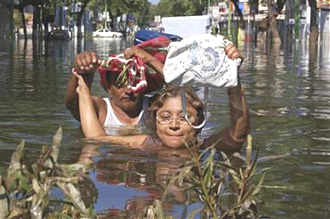 |
 |
 |
 News Around the Republic of Mexico | November 2007 News Around the Republic of Mexico | November 2007  
Fears Over Aftermath of Mexico Floods
 Elisabeth Malkin - NYTimes Elisabeth Malkin - NYTimes
go to original


| | A couple wade through neck-deep floodwaters in a neighborhood of Villahermosa, the state capital of Tabasco, November 6, 2007. (Manuel Lopez/Reuters) |
Villahermosa, Mexico — Additional teams of medical workers and police officers from other parts of Mexico flew into the state of Tabasco today as authorities raised concerns about escalating health problems and looting after the five days of heavy rains last week that put much of the low-lying state under water.

The swollen rivers that had flooded much of Tabasco continued to recede today, but as streets once again become passable the authorities said they were worried that the improved conditions would help looters. The flooding has forced tens of thousands of residents from their homes, and many are still living in shelters, or staying in hotels or camping by roads.

Rescue workers continued to search for the 16 people missing after a hillside gave way in the neighboring state of Chiapas, where the same heavy rains that caused the floods had cut off some mountain villages.

The mudslide, on Sunday, swept into the Grijalva River so fast that it created a wave that covered the village of San Juan Grijalva, dragging people into the water, Mexico’s Interior Ministry said. On Monday, helicopters flew soldiers and police officers to assist survivors and search for the dead.

Until the mudslide, the death toll after the floods had stood at less than 10 in both Tabasco and Chiapas.

Although the waters have begun to recede, the region is still struggling with problems left behind by the waters. In Villahermosa, the state capital of Tabasco, lines up to seven hours long formed at government relief centers as the displaced people waited to pick up water, milk, food and medical supplies.

Helicopters flew to communities that had been cut off more than a week. They carried Red Cross supplies, bottled water and much-needed medicine, along with doctors to offer basic care and help evacuate the sick.

Inside the city, rescue boats and private boats traveled the flooded streets, looking for people in trouble and handing out supplies.

Yet in parts of the city on Monday, life went on as if its inhabitants had not just been through the worst flooding in its history.

In a well-stocked supermarket in the city’s center, save for a run on diapers and water, there were few signs that anything was out of the ordinary.

Those who could — even some in shelters — returned to work. Schools that had not been damaged reopened for classes.

And traffic choked the streets that were not flooded, as it would on any Monday morning. Passing trucks of soldiers and the overhead whir of helicopters were the only signs in some areas that anything was different.

Next to the supermarket, however, the convention center and its covered parking lot were serving as a giant shelter for the displaced, where families spread out the few belongings they had saved and women washed clothes and laid them out to dry.

Inside, stretched out in rows, families tried to create a little space for themselves. In one area, doctors and nurses tended to long lines of evacuees, many of them suffering from skin and fungal infections caused by wading through the water.

“Sometimes it’s not the insect bite, they just want to be heard,” said Dr. Rabindranath Sansores, a doctor for the state government working in the shelter.

People waited in the hot sun to collect food and water that was being handed out at the governor’s mansion. Inside, volunteers sorted through mounds of used clothes, stacks of water bottles and toilet paper that were spread out on black tarpaulins over the grass of the lush grounds.

The governor, Andrés Granier, had opened up the grounds to the evacuees, housing them on a covered patio normally used for official ceremonies.

María Victoria García, a secretary, and her husband, Gumercindo Dominguez Ramos, a construction worker, sat on the governor’s wicker chairs and watched a television they had rescued from their house. They said they were being treated well.

In Santa Catalina, a tiny ranching and farming town on the banks of the Samaria River, the first helicopter arrived Monday, bringing food and water.

The water that had covered the fields and cut off a seven-mile dirt road that led to the main road had retreated, and the villagers began cleaning the mud from their houses. They had been lucky: the village’s small shop was not flooded, and there had been enough canned food and water to last the week. But now they were running out.

Dominga Peralta spent much of the past week in the rafters of her house; she had laid planks to form a loft under the roof. On Monday, she came down. The three feet of water that had covered the fields outside and swept into her house had receded.

“All this will die,” she said, pointing to the mud-soaked grass outside her tin-roofed wood house. “But, thank God, we’re on dry land now.” | 
 | |
 |



